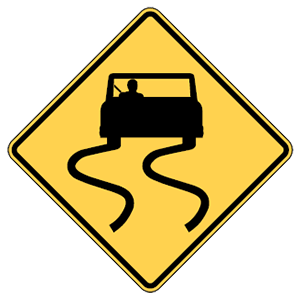2025 Maine Permit Test 11
The following questions are from real DMV written tests. These are some of the actual permit questions you will face in Maine. Each permit practice test question has three answer choices. Select one answer for each question and select "grade this section." You can find this button at the bottom of the drivers license quiz. For a complete list of questions and answers for Maine please visit https://cheat-sheets.dmv-written-test.com/en/maine/car.
Number of Tests
Number of Question
Passing Score
17. When entering the interstate, check for a gap in traffic in the nearest lane, adjust your speed to match traffic, signal, and:
Explanation
Before merging into interstate traffic, you should identify a gap, accelerate to the speed of traffic, and signal. Merge into the gap when it is safe to do so. Be alert to other traffic and do not expect other drivers to clear the lane.
18. This road sign means:

Explanation
Warning signs provide notice to road users of a situation that might not be readily apparent and are usually yellow with black markings. This sign warns drivers to be careful when driving under wet conditions as the pavement will become slippery and more difficult to navigate safely.
19. When driving at night on a dimly lit street, you should:
Explanation
You should drive more slowly at night than during the day because it is not possible to see as far ahead at night. You should make sure that you can stop within the area illuminated by your headlights.
20. What should you do when you are going to enter a roadway from a private road?
Explanation
When entering a roadway from a driveway or private road, you must yield the right-of-way to pedestrians and traffic on the roadway.
21. What does a flashing yellow traffic light mean?
Explanation
A flashing yellow traffic light indicates that you should drive with caution.
22. You should not use your horn:
Explanation
When driving near a blind pedestrian, using your horn may be dangerous. Yield to the pedestrian and proceed when it is safe to do so.
23. You should honk your horn when you:
Explanation
Your horn should be used as a warning in situations where you think another driver or a pedestrian does not see you. For example, if a child begins to run into the street in front of your vehicle, you should sound your horn.
24. A diamond-shaped sign:
Explanation
Diamond-shaped signs warn drivers of existing or potential driving hazards. You will usually see these signs in yellow or orange.
Ranked by best match
